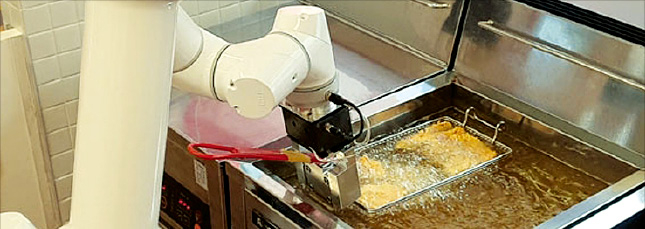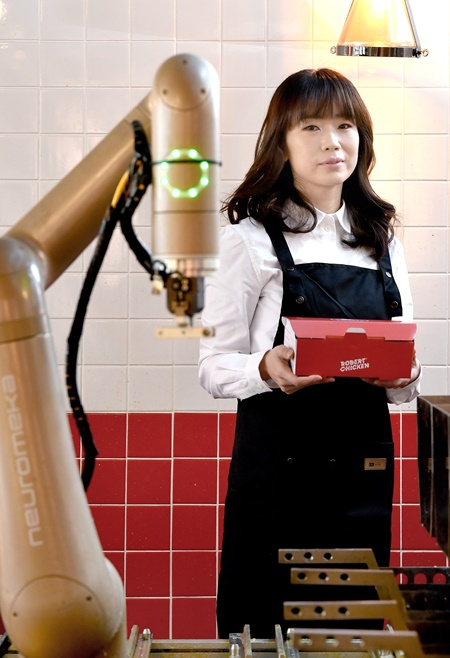Chicken startup shakes up crowded market with robotic arms
Robo Arete, founded by an ex-venture capitalist, makes robotic arms to deliver quality, tasty fried chicken
By Feb 22, 2022 (Gmt+09:00)
LG Chem to sell water filter business to Glenwood PE for $692 million


Kyobo Life poised to buy Japan’s SBI Group-owned savings bank


KT&G eyes overseas M&A after rejecting activist fund's offer


StockX in merger talks with Naver’s online reseller Kream


Mirae Asset to be named Korea Post’s core real estate fund operator



Preparing fried chicken requires a simple, but laborious process: Placing pieces of chicken on dough and frying powder; putting them into an iron basket to fry in the hot oil of 170 degrees Fahrenheit for nine and a half minutes; and shaking the basket several times to prevent them sticking together.
At Robert Chicken, operated by food tech startup Robo Arete, all the chores are done by a robot, more precisely, a robotic arm.
Back in 2018, its founder and CEO Kang Ji-young got the idea of starting a chicken franchise with a chicken-frying robot, while working as a local venture capitalist.
"I thought the day would come where a robot fries chicken and a drone delivers it," she told The Korea Economic Daily.
"But there was no such startup in South Korea, so I started the business."
Robo Arete, established in September 2018, develops kitchen robots to replace human cooks.
It also operates six franchise stores of Robert Chicken mostly in southern Seoul, which offer take-out and delivery services. Their average daily revenue tops 1 million won ($840) to meet break-even points, while the stores vary in size.
"A robot arm can fry up to 50 chickens for an hour ... It can replace three part-timers," Kang said in a recent interview.
The three-year-old startup has already received an undisclosed amount of funding from Bluepoint Partners, a domestic startup accelerator; Naver Corp's investment arm DS2F; and We Ventures, a venture capital firm.
The forte of Robert Chicken lies in delivering fried chicken of identical taste and quality, regardless of the branch, on top of the robot's labor efficiency.
To serve fried chicken, the robotic arm evenly places the chicken pieces on the flour and then frying powder to get crispy skins.
In the middle of frying, the robot keeps shaking the chicken basket but only a limited number of times to prevent overcooking. Before mixing the cooked chicken with sauce, it shakes the basket again to remove residual oil.
To maintain the taste and quality of its food, the franchise also restricts the reuse of frying oil.

CEO Kang envisions a chicken franchise store staffed by only one human worker, who takes orders and packages the food, while the robot takes the heat in the kitchen frying the chicken.
In the labor-intensive industry, Kang stressed that her franchise stores will be able to reduce labor costs, which have been on an upward run since the pandemic hit.
She is aiming to introduce her franchise in the US and other overseas markets within the year, serving various chicken recipes such as chicken burgers, chicken wings, the Indian dish of chicken masala, and the American favorite of chicken and waffles.
"We will develop recipes for New Yorkers and serve them with Robert Chicken," Kang said.
Write to Jin-won Kim at jin1@hankyung.com
Yeonhee Kim edited this article.
-
 Franchise industryKyochon F&B, Galadari tie-up brings Korean fried chicken to Middle East
Franchise industryKyochon F&B, Galadari tie-up brings Korean fried chicken to Middle EastApr 12, 2021 (Gmt+09:00)
2 Min read -
 Franchise industryKorean fried chicken brand reports all-time high earnings in 2020
Franchise industryKorean fried chicken brand reports all-time high earnings in 2020Feb 16, 2021 (Gmt+09:00)
2 Min read -
 Fried chickensKorea’s fried chicken brands fly high on food delivery boom
Fried chickensKorea’s fried chicken brands fly high on food delivery boomDec 30, 2020 (Gmt+09:00)
3 Min read


